Do Baby Bunnies Leave the Nest All a Once

This is a blackbird nest. Once the eggs have hatched and are gone, the bird volition no longer use the nest.
A bird nest is a place where a bird lays its eggs. At that place are all kinds of nests, including cup nests, holes in the basis, and piles of twigs and leaves. The word can be used as a noun or a verb, as in – a bird nests in a nest. They are in all kinds of sizes: some can be as big and heavy every bit a car, like an quondam hawkeye'south nest, while some tin be tiny as a thimble, like the nest of a Bee Hummingbird.
Contents
- Making a home
- Types of nests
- Cup nest
- Adherent nests
- Platform nests
- Globe-pigsty nests
- Ground and mound nests
- Scrape nests
- Other
- Images for kids
Making a home
Usually, the female builds the nest, and the male helps her. In some species, though, the male person does cypher, and in others, the male builds the nest and the female person does nothing.
Many birds "glue" their nests together with materials similar spider webs, silk, mud, and even their own saliva (spit). Nigh nest builders like to put soft things inside their nest. Some birds fifty-fifty put herbs and spices in their nest. Scientists think these herbs help fight off bacteria in a way they can't completely understand yet.
Types of nests
Cup nest
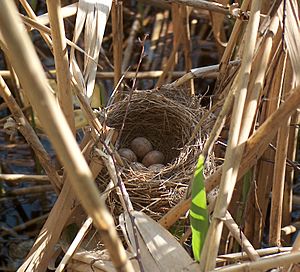
Loving cup nest of the Nifty Reed-warbler

Cup nest of a Redwing, with infant chicks. Virtually all birds build cup nests like this.
The cup nest is probably the most common bird nest. Its name tells yous that a cup nest is shaped like a cup or bowl. Many songbirds congenital cup nests. These nests can be built in the branches of a tree, similar in the cleft where one branch joins another: however, some can simply stick the nest correct onto the co-operative of a tree. They use lots of materials that act similar gummy glue – mud, rotten wood, dung, spider webs, and caterpillar silk. . They sometimes even apply their own saliva mixed with food to keep the nest firmly stuck on the branch.
Cup nesters use all kinds of materials to build a nest: twigs (tiny branches), grass, leaves, moss; and they use all sorts of materials to go on information technology from falling apart. Most cup nesters use rough, scratchy material for the outside (this gives protection and camouflages the rest), and put soft, cozy material like moss, fur, feathers, and cotton on the inside.
Many loving cup nesters savor nesting very shut to the ground in low bushes – sometimes they will fifty-fifty nest in potted plants on a porch. Some of them really just build their nests on the ground. Sparrows, cardinals, and many other song birds (called passerines), like to nest near the ground, far away from owls, hawks, and Blue Jays that may eat their babies.
There are several types of cup nests. A suspended cup nest is fastened to the branch at the top and sides only then drops similar a handbag downward beneath. It really looks more like a vase than a cup. The bird is most hidden when she warms her eggs. The mother bird can sit downwards on the co-operative higher up the nest and bend downward to feed her infant birds. Orioles are very famous for building amazingly long bags that hang far beneath the co-operative.
The smallest loving cup nests are fabricated by hummingbirds. They can be as tiny every bit a thimble, like the Bee Hummingbird's nest. That tiny nest holds eggs that are as tiny as peas. The largest cup nest is probably the stork's. His nest tin can be nine feet deep and six feet wide. The stork's nest is then big that smaller birds actually make nests in its cracks, holes, and branches.
Adherent nests
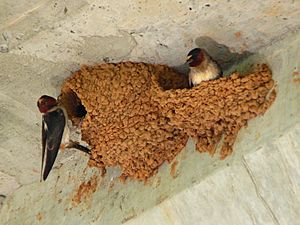
Two Cliff Swallows making mud nests. Notice how the nest sticks to the wall of this building.
Adherent nests adhere (stick) to buildings, trees, cliffs, or other vertical structures. Swallows can build an almost perfectly circular nest out of mud. Some species make loving cup-shaped nests, while others make jug-similar nests with little holes in the sides. They put petty assurance of mud in their mouth and mix information technology with their saliva, making a special clay. As it dries, it becomes hard.
Bird saliva is very good for making glue: in fact, some species of swiftlets make their whole nest out of simply saliva. The male regurgitates (throws up) a long, thin strand of saliva from glands under its tongue. This saliva is used to be made into a half-cup nest which sticks to a cavern wall (swiftlets like to build their nests in caves and grottos) and dries quickly. This saliva nest is thought to be a delicacy (something really yummy to swallow) in China, and it is very expensive. They put information technology into a soup chosen Bird's Nest Soup.
Platform nests
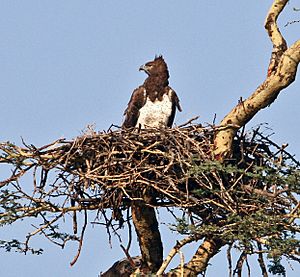
Nest of Polemaetus bellicosus (Martial Eagle)
Platform nests are built generally past raptors (birds that eat casualty, similar eagles and hawks). They are commonly huge and very, very high up - on the sides of cliffs, maybe, or high upward in a big tree. Information technology takes months and months making these nests, adding co-operative by branch. They often return to the aforementioned nest year after twelvemonth and continue to build it. It is considering of this that platform nests get and so large: a Baldheaded Eagle's nest, for case, can weigh equally much as a ton (near the aforementioned weight as a pocket-size car). Information technology is so heavy it can sometimes hurt the tree it is built in.
A few h2o birds (like grebes and loons) build platform nests right on the h2o, where they tin can float. The nests don't movement, though, because they are anchored to plants that are fastened to the lesser of the body of h2o. These birds build nests on water because they don't walk well on land, then they find a shallow (non deep) role of the water to build their nests. So, they practice not walk to their nests - they swim to it. When the babies are ready, they merely jump into the water and begin their aquatic (water) life.
Earth-pigsty nests

Farne Islands Puffin in couch
Earth-hole nests are nests that are inside the earth. They are burrows (tunnels) on the ground or in the sides of cliffs. They like using abandoned rabbit holes, too. The Burrowing Owl only uses already dug holes for its nest.
Puffins, for example, dig a tunnel that is ordinarily ii to iii anxiety long. At the cease they make a nest of feathers and grass and lay their eggs. They are able to do this because of their precipitous bill and claws. A puffin can work for hours to make its tunnel. Kingfishers, too, dig or burrow their holes. They can burrow up to six anxiety into the side of a cliff and lay their eggs in that place.
Ground and mound nests
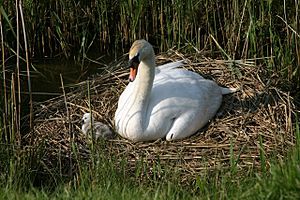
Many birds nest right on the ground. Afterward carving out a little hole, ground and mound nesters line the nest with grass or other materials. Geese even pick feathers from their breasts and make a nice downy bed for their eggs. Most ducks, geese, and quail like the ground for nesting. Penguins nest on the ground, as well, pushing rocks effectually the nest to keep information technology from washing away with overflowing waters. Usually, males brand ground nests.
The Trumpeter Swan makes a big mound nest, and flamingos make mounds, too. Flamingos brand their mounds completely out of mud. They can be upwards to 18 inches high and 12 to xx inches in width.
Scrape nests
These nests are barely a nest at all – just a small low in the footing or a pile of expressionless leaves to lay eggs on. These scrape-nesting birds unremarkably have eggs that match the colour of dead leaves or rocks. This is needed considering these eggs are in danger of being eaten by animals similar rats, raccoons, snakes, and others that eat eggs.
Many scrape nesters actually try to distract creatures that might exist dangerous by pretending they have a broken wing. This makes a predator chase the mother bird, and leave the eggs.
Other
- Nest
- Egg (biological science)
- Bird
- Feather
- Flight
Images for kids
-
Some nest linings, such every bit the beat fragments in this Charadrius plover scrape, may help to foreclose the eggs from sinking into muddy or sandy soil.
-

Other nest linings, similar the lichen in this American golden-plover scrape, may provide some level of insulation for the eggs, or may assistance to camouflage them.
-

right
-

The mound nests of flamingos, similar these Chilean flamingos, help to protect their eggs from fluctuating h2o levels.
-

Like well-nigh burrow-nesting species, sand martins dig a horizontal tunnel into a vertical clay cliff.
-

Increased vulnerability to predators may have led some burrow-nesting species, like the European bee-eater, to go colonial breeders.
-

"Secondary cavity nesters", like this blue-winged parrotlet, use natural cavities or holes excavated by other species.
-

But a relatively pocket-size number of species, including the woodpeckers, are capable of excavating their own cavity nests.
-

Like many small birds, the imperial-crowned fairy uses considerable amounts of spider silk in its cup nest.
-
Many raptors, like the osprey, use the same huge platform nest for years, adding new material each season.
-
Taveta golden weaver building pendant nest.
-

A human-made nest platform in Poland congenital every bit a conservation measure and to prevent storks disrupting electricity supplies through nesting on pylons. Three young white storks are on the peak of the nest and ii Eurasian tree sparrows are perching on the side of the nest.
All content from Kiddle encyclopedia manufactures (including the article images and facts) can exist freely used under Attribution-ShareAlike license, unless stated otherwise. Cite this commodity:
Bird nest Facts for Kids. Kiddle Encyclopedia.
Source: https://kids.kiddle.co/Bird_nest

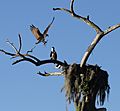

0 Response to "Do Baby Bunnies Leave the Nest All a Once"
Post a Comment